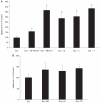Interaction of ocular hypotensive agents (PGF2 alpha analogs-bimatoprost, latanoprost, and travoprost) with MDR efflux pumps on the rabbit cornea
- PMID: 20028257
- PMCID: PMC3096535
- DOI: 10.1089/jop.2009.0049
Interaction of ocular hypotensive agents (PGF2 alpha analogs-bimatoprost, latanoprost, and travoprost) with MDR efflux pumps on the rabbit cornea
Abstract
Purpose: The objectives of this work were (i) to screen ocular hypotensive prostaglandin (PGF2 alpha) analogs--bimatoprost, latanoprost, and travoprost as well as their free acid forms--for interaction with efflux pumps on the cornea and (ii) to assess the modulation of efflux upon co-administration of these prostaglandin analogs.
Methods: Cultured rabbit primary corneal epithelial cells (rPCEC) were employed as an in vitro model for rabbit cornea. Transporter-specific interaction studies were carried out using Madin-Darby canine kidney (MDCK) cells overexpressing MDR1, MRP1, MRP2, MRP5, and BCRP. Freshly excised rabbit cornea was used as an ex vivo model to determine transcorneal permeability.
Results: Cellular accumulation studies clearly showed that all prostaglandin analogs and their free acid forms are substrates of MRP1, MRP2, and MRP5. Bimatoprost was the only prostaglandin analog in this study to interact with P-gp. In addition, none of these molecules showed any affinity for BCRP. K (i) values of these prostaglandin analogs obtained from dose-dependent inhibition of erythromycin efflux in rPCEC showed bimatoprost (82.54 microM) and travoprost (94.77 microM) to have similar but higher affinity to efflux pumps than latanoprost (163.20 microM). Ex vivo studies showed that the permeation of these molecules across cornea was significantly elevated in the presence of specific efflux modulators. Finally, both in vitro and ex vivo experiments demonstrated that the efflux of these prostaglandin analogs could be modulated by co-administering them together.
Conclusion: Bimatoprost, latanoprost, travoprost, and their free acid forms are substrates of multiple drug efflux pumps on the cornea. Co-administration of these molecules together is a viable strategy to overcome efflux, which could simultaneously elicit a synergistic pharmacological effect, since these molecules have been shown to activate different receptor population for the reduction of intraocular pressure (IOP).
Figures





Similar articles
-
Expression of multidrug resistance associated protein 5 (MRP5) on cornea and its role in drug efflux.J Ocul Pharmacol Ther. 2009 Apr;25(2):121-32. doi: 10.1089/jop.2008.0084. J Ocul Pharmacol Ther. 2009. PMID: 19323627 Free PMC article.
-
Corneal alterations induced by topical application of commercial latanoprost, travoprost and bimatoprost in rabbit.PLoS One. 2014 Mar 14;9(3):e89205. doi: 10.1371/journal.pone.0089205. eCollection 2014. PLoS One. 2014. PMID: 24632558 Free PMC article.
-
Ocular surface tolerability of prostaglandin analogs in patients with glaucoma or ocular hypertension.J Ocul Pharmacol Ther. 2010 Jun;26(3):287-92. doi: 10.1089/jop.2009.0134. J Ocul Pharmacol Ther. 2010. PMID: 20578283 Clinical Trial.
-
Prostaglandin analog treatment of glaucoma and ocular hypertension.Ann Pharmacother. 2002 Mar;36(3):504-11. doi: 10.1345/aph.1A178. Ann Pharmacother. 2002. PMID: 11895065 Review.
-
Bimatoprost and travoprost: a review of recent studies of two new glaucoma drugs.Surv Ophthalmol. 2002 Aug;47 Suppl 1:S105-15. doi: 10.1016/s0039-6257(02)00327-2. Surv Ophthalmol. 2002. PMID: 12204706 Review.
Cited by
-
Topical, Aqueous, Clear Cyclosporine Formulation Design for Anterior and Posterior Ocular Delivery.Transl Vis Sci Technol. 2015 May 1;4(3):1. doi: 10.1167/tvst.4.3.1. eCollection 2015 May. Transl Vis Sci Technol. 2015. PMID: 25964868 Free PMC article.
-
A randomized crossover study comparing tafluprost 0.0015% with travoprost 0.004% in patients with normal-tension glaucoma [corrected].Clin Ophthalmol. 2012;6:1579-84. doi: 10.2147/OPTH.S33414. Epub 2012 Sep 25. Clin Ophthalmol. 2012. PMID: 23055682 Free PMC article.
-
Extended latanoprost release from commercial contact lenses: in vitro studies using corneal models.PLoS One. 2014 Sep 10;9(9):e106653. doi: 10.1371/journal.pone.0106653. eCollection 2014. PLoS One. 2014. PMID: 25207851 Free PMC article.
-
Interaction Studies of Resolvin E1 Analog (RX-10045) with Efflux Transporters.J Ocul Pharmacol Ther. 2015 May;31(4):248-55. doi: 10.1089/jop.2014.0144. Epub 2015 Apr 6. J Ocul Pharmacol Ther. 2015. PMID: 25844889 Free PMC article.
-
Nanomicellar Topical Aqueous Drop Formulation of Rapamycin for Back-of-the-Eye Delivery.AAPS PharmSciTech. 2015 Jun;16(3):610-22. doi: 10.1208/s12249-014-0244-2. Epub 2014 Nov 26. AAPS PharmSciTech. 2015. PMID: 25425389 Free PMC article.
References
-
- Macha S., Hughes P.M., Mitra A.K. Mitra A.K. Ophthalmic Drug Delivery Systems. ed. New York: Marcel Dekker; 2003. Overview of ocular drug delivery; pp. 1–12.
-
- Dey S., Gunda S., Mitra A.K. Pharmacokinetics of erythromycin in rabbit corneas after single-dose infusion: role of P-glycoprotein as a barrier to in vivo ocular drug absorption. J. Pharmacol. Exp. Ther. 2004;311:246–255. - PubMed
-
- Dey S., Patel J., Anand B.S., et al. Molecular evidence and functional expression of P-glycoprotein (MDR1) in human and rabbit cornea and corneal epithelial cell lines. Invest. Ophthalmol. Vis. Sci. 2003;44:2909–2918. - PubMed
Publication types
MeSH terms
Substances
Grants and funding
LinkOut - more resources
Full Text Sources
Other Literature Sources
Medical
Miscellaneous

